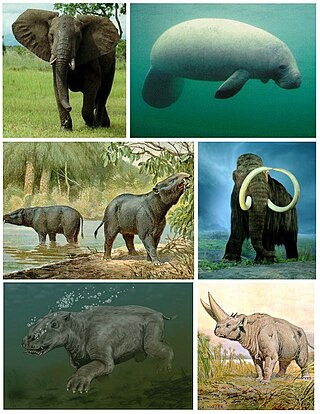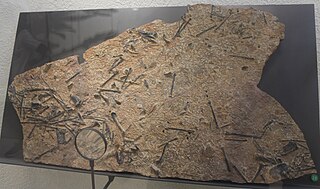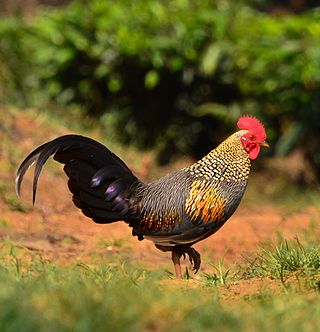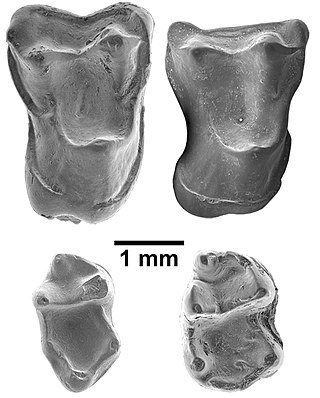
Perissodactyla is an order of ungulates. The order includes about 17 living species divided into three families: Equidae, Rhinocerotidae (rhinoceroses), and Tapiridae (tapirs). They typically have reduced the weight-bearing toes to three or one of the five original toes, though tapirs retain four toes on their front feet. The nonweight-bearing toes are either present, absent, vestigial, or positioned posteriorly. By contrast, artiodactyls bear most of their weight equally on four or two of the five toes: their third and fourth toes. Another difference between the two is that perissodactyls digest plant cellulose in their intestines, rather than in one or more stomach chambers as artiodactyls, with the exception of Suina, do.

Omomyidae is a group of early primates that radiated during the Eocene epoch between about 55 to 34 million years ago (mya). Fossil omomyids are found in North America, Europe & Asia, making it one of two groups of Eocene primates with a geographic distribution spanning holarctic continents, the other being the adapids. Early representatives of the Omomyidae and Adapidae appear suddenly at the beginning of the Eocene in North America, Europe, and Asia, and are the earliest known crown primates.

Adapidae is a family of extinct primates that primarily radiated during the Eocene epoch between about 55 and 34 million years ago.

Lemuriformes is the sole extant infraorder of primate that falls under the suborder Strepsirrhini. It includes the lemurs of Madagascar, as well as the galagos and lorisids of Africa and Asia, although a popular alternative taxonomy places the lorisoids in their own infraorder, Lorisiformes.
Pilgrimella is an extinct early Eocene genus of anthracobunid, a group of stem perissodactyls. It was a ground dwelling grazer with massive bilophodont molars Dental remains of this animal have been found in Chorlakki, Punjab province, Pakistan, and in the Subathu Formation in North-West India.

Tethytheria is a clade of mammals that includes the sirenians, proboscideans, and the extinct order Embrithopoda.

Presbyornis is an extinct genus of presbyornithid bird from North America during the Paleogene period, between the Late Paleocene and Early Eocene.

Anthracobunidae is an extinct family of stem perissodactyls that lived in the early to middle Eocene period. They were originally considered to be a paraphyletic family of primitive proboscideans possibly ancestral to the Moeritheriidae and the desmostylians. The family has also thought to be ancestral to the Sirenia.
"Precursor" is a controversial prehistoric bird genus from the Early Eocene. It was established based on fossils found in England, including in the famous London Clay deposits. Three species are included in the genus: "P." parvus, the type species, "P." magnus, and "P." litorum, all named by Colin Harrison and Cyril Walker in 1977.

Dyrosaurus is a genus of extinct crocodylomorph that lived during the early Eocene. The name Dyrosaurus comes from sauros (σαῦρος) the Greek for lizard or reptile, and Dyr for Djebel Dyr (mountain) close to where the type species was discovered. It was a large reptile with an estimated body length of 6.5 metres (21 ft).

Titanohyrax is an extinct genus of large to very large hyrax from the Eocene and Oligocene. Specimens have been discovered in modern-day Algeria, Tunisia, Egypt and Libya. Some species, like T. ultimus, are estimated to be as large as the modern rhinoceros. Titanohyrax species are still poorly known due to their rarity in the fossil record.

Cetancodontamorpha is a total clade of artiodactyls defined, according to Spaulding et al., as Whippomorpha "plus all extinct taxa more closely related to extant members of Whippomorpha than to any other living species". Attempts have been made to rename the clade Whippomorpha to Cetancodonta, but the former maintains precedent.

Pangalliformes is the scientific name of a provisional clade of birds within the group Galloanserae. It is defined as all birds more closely related to chickens than to ducks, and includes all modern chickens, turkeys, pheasants, and megapodes, as well as extinct species that do not fall within the crown group Galliformes.
Avolatavis is an extinct genus of stem-parrot (pan-psittaciform) or a member of the stem group of Psittacopasseres, known from the early Eocene Fossil Butte Member of the Green River Formation of Wyoming, United States, and from the London Clay of Walton-on-the-Naze. It was first named by Daniel T. Ksepka and Julia A. Clarke in 2012 and the type species is Avolatavis tenens. Gerald Mayr and Andrew C. Kitchener described the second species, A. europaeus, in 2023. Mayr and Kitchener assigned Avolatavis to the family Vastanavidae, which might be early diverging stem group presentatives of Pan-Psittaciformes or stem group representatives of Psittacopasseres.
Azibiidae is an extinct family of fossil primate from the late early or early middle Eocene from the Glib Zegdou Formation in the Gour Lazib area of Algeria. They are thought to be related to the living toothcombed primates, the lemurs and lorisoids, although paleoanthropologists such as Marc Godinot have argued that they may be early simians. It includes the genera Azibius and Algeripithecus, the latter of which was originally considered the oldest known simian, not a strepsirrhine.
Djebelemur is an extinct genus of early strepsirrhine primate from the late early or early middle Eocene period from the Chambi locality in Tunisia. Although they probably lacked a toothcomb, a specialized dental structure found in living lemuriforms, they are thought to be a related stem group. The one recognized species, Djebelemur martinezi, was very small, approximately 100 g (3.5 oz).
Djebelemuridae is an extinct family of early strepsirrhine primates from Africa. It consists of five genera. The organisms in this family were exceptionally small, and were insectivores. This family dates to the early to late Eocene. Although they gave rise to the crown strepsirrhines, which includes today's lemurs and lorisoids, they lacked the toothcomb that identifies that group.

Afrasia djijidae is a fossil primate that lived in Myanmar approximately 37 million years ago, during the late middle Eocene. The only species in the genus Afrasia, it was a small primate, estimated to weigh around 100 grams (3.5 oz). Despite the significant geographic distance between them, Afrasia is thought to be closely related to Afrotarsius, an enigmatic fossil found in Libya and Egypt that dates to 38–39 million years ago. If this relationship is correct, it suggests that early simians dispersed from Asia to Africa during the middle Eocene and would add further support to the hypothesis that the first simians evolved in Asia, not Africa. Neither Afrasia nor Afrotarsius, which together form the family Afrotarsiidae, is considered ancestral to living simians, but they are part of a side branch or stem group known as eosimiiforms. Because they did not give rise to the stem simians that are known from the same deposits in Africa, early Asian simians are thought to have dispersed from Asia to Africa more than once prior to the late middle Eocene. Such dispersals from Asia to Africa also were seen around the same time in other mammalian groups, including hystricognathous rodents and anthracotheres.
Suzanniwana is an extinct genus of iguanian lizards that lived in western North America during the earliest Eocene, approximately 56 million years ago. Two species are known from the Bighorn Basin of Wyoming: the type species S. patriciana named in 2009, and the species S. revenanta named in 2013. Suzanniwana lived during the Paleocene–Eocene Thermal Maximum, a brief period of global warming that resulted in warmer and drier conditions in the Bighorn Basin. It likely stemmed from a lineage that had migrated into the basin from regions farther to the south, following a latitudinal band of constant climatic conditions that moved northward as the planet warmed. Suzanniwana shares many skeletal features with modern casquehead lizards of the family Corytophanidae and may be a stem-corytophanid. It also closely resembles Geiseltaliellus, an iguanian from the middle Eocene Messel pit in Germany.
Agnopterus is an extinct genus of stem-flamingo phoenicopteriform with fossil material from France, as well as possibly England, Kazakhstan, and Brazil. The holotype specimen for type species A. laurillardi is an incomplete distal tibiotarsus from Late Eocene gypsum from Paris; a coracoid, humeri, a scapula and perhaps a proximal femur have been recovered from Late Eocene to Early Oligocene of England to a possible second species, A. hantoniensis. Two additional species from the Late Oligocene-Early Miocene have been named as well. A. turgaiensis of Kazakhstan and A. sicki of Brazil. While all four species are considered to be close to the ancestry of flamingos, their exact relationships and placement as members of Agnopterus is uncertain.















